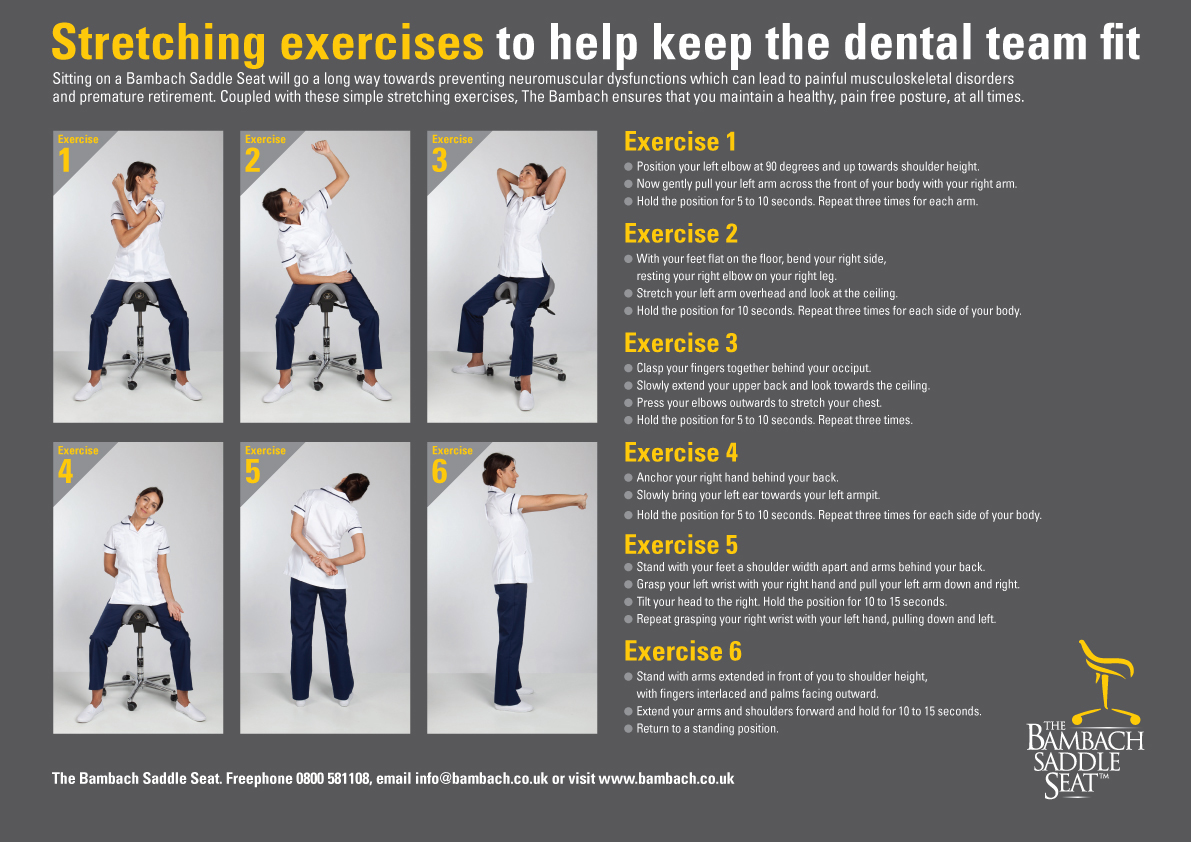By using the Bambach Saddle Seat you are taking an important step towards having a longer, more efficient and pain-free working life. This is because the Bambach ensures your spine remains in an optimum position at all times, thus addressing the key requirements for preventing musculoskeletal disorders.
These factors include:
The back of the patients head should be at approximately the same level as the operator’s elbow.
Neck postures with more than 20º of bending are found to be associated with neck pain.
Upper back
Excessive bending of the neck can lead to over-flexing of the upper back.
Raised shoulders have been found to increase upper trapezius muscle activity and may lead to discomfort and pain.
Elbows should be positioned at around 100º to 110º of flexion, and the wrists in neutral or slight extension.
Lower back
The lower back should be positioned in slight lumbar lordosis (inward curving).
Pelvis and hips
The operator’s seat should be tilted (anteriorly) to around 15º and hips should be at an angle of 110º to 120º.
The knees should be positioned under the dental chair where possible.
Feet
These should be kept flat on the floor. This allows body weight to be transferred through the legs and reduces active loading of back muscles.
Historically, the role of posture has been an under-rated factor in the health of dental professionals. Now, however, the true importance of posture is beginning to emerge as a result of a variety of in-depth studies of health and occupation risk in the dental profession. As a result of these studies, it is now known that musculoskeletal disorders, often caused by poor posture, are a major reason for the premature retirement among dentists. Results from other studies have shown that the incidence of pain, among dental hygienists, resulting from poor posture is worryingly high at 96%. The studies also indicated that a number of other occupational risk factors can be traced to the same cause (poor working posture).
This, of course, begs an obvious question: what can be done about it? What, as a dental professional, can you do to minimise, or even eliminate, the possibility of discomfort or pain, and any associated lack of working efficiency, from musculoskeletal disorders? Well, there is an answer, and it lies, perhaps unsurprisingly, with the removal of the root-cause of musculoskeletal problems - poor operational posture. But before we look at how this can be easily achieved, it’s worth being clear on what we mean by a ‘musculoskeletal disorder’, and what causes them.
Essentially, a musculoskeletal disorder is a condition that affects nerves, tendons, muscles and supporting structures such as inter-vertebral discs. Typically affecting the neck, shoulder, back, wrist and hand, symptoms range from mild periodic pain or discomfort to severe chronic pain or discomfort. The most common telltale signs that you’re suffering from such a condition include a decreased range of motion, deformity, decreased grip strength and loss of muscle function. Accompanying symptoms include pain, numbness, tingling, burning, cramping and stiffness.
In dentistry, there are a number of factors that have been identified as contributing to musculoskeletal disorders. These factors are primarily related to workplace ergonomics, which have a significant effect on operational habits and working posture. In particular, movements or actions that can cause or exacerbate a musculoskeletal disorder include:
• Frequent or prolonged use of vibrating tools
• Forceful hand exertions, such as squeezing or release of instruments
• Repetitive movements of hand and wrist
• Fixed or awkward postures of the neck, back and shoulders
• Lack of upper extremity support during work
• Abnormal positioning of wrist and hand
• Poor positioning while treating patient
• Poor organisation of instruments.
There are several actions you can take that will help you eliminate the cause of musculoskeletal disorders, including simple chairside exercises (ask for our free wall chart), taking regular breaks and avoiding prolonged work hours. However, the most important preventative action you can take is to ensure that you maintain an ideal operating posture. This requires that the spine is maintained in its normal s-shape when seated. As many dentists like yourself already know, the Bambach Saddle Seat has been proven to ensure that this is the case.
